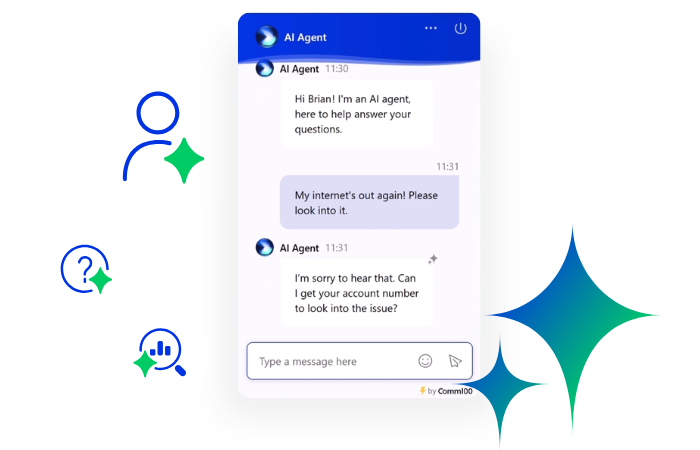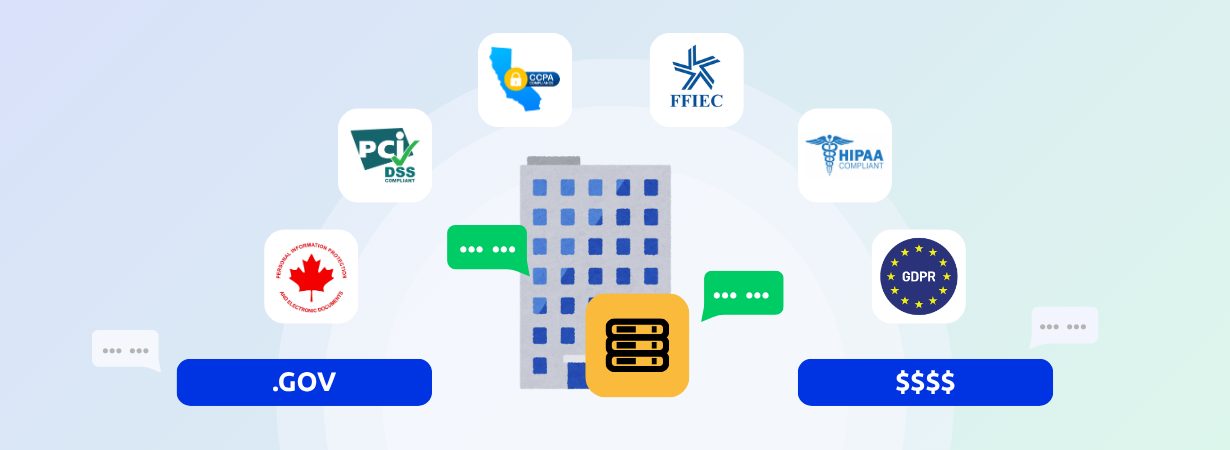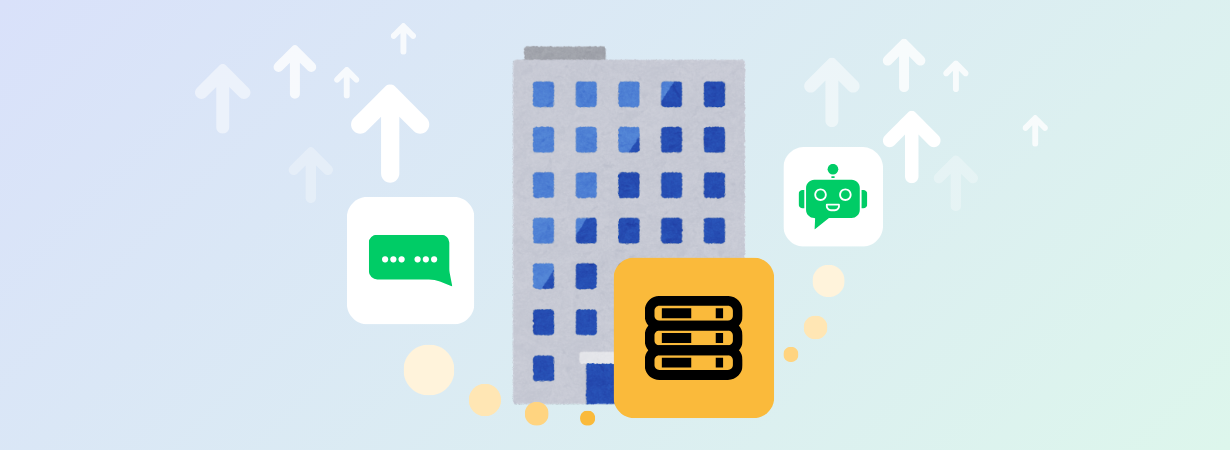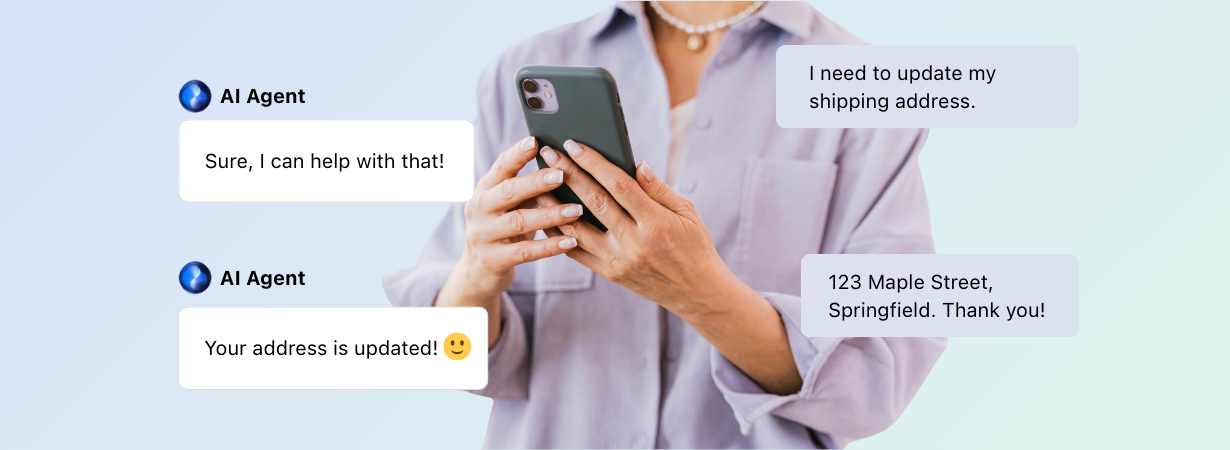Digital technology has transformed customer expectations in recent years, and the banking industry is now playing catch-up. Technology leaders like Amazon and Apple have offered customers seamless experiences across digital devices for years, and it’s only natural that consumers should expect the same experience from their financial institutions too.
Live chat is being introduced across the banking industry to offer customers a more flexible way to connect, but there’s still room for improvement. Many banks are missing out on the opportunities created by automating chats with chatbots.
This blog will look at the benefits of banking AI chatbots, some of the common use cases for AI-powered chatbots in banking and – perhaps most importantly – the cost saving benefits of introducing bots into customer service.
Top 5 benefits of banking AI chatbots
As we begin our look at the benefits of AI-powered chatbots in banking, it’s worth starting with an obvious one, and the reason that chatbot use is growing – customers want to use chatbots! A recent study showed that 70% of consumers are either already using or interested in using chatbots for simple customer service. With chatbots continuing to increase in popularity, experts predict that chatbot demand among consumers will continue to grow as well.
In this section, we’ll dig into the benefits behind AI chatbots to see why they’re growing in popularity among both customers and financial institutions alike.
1. Improved support efficiency
One of the big reasons that 40% of internet users prefer to interact with chatbots over human agents is for their incredibly efficient support. A single AI chatbot can handle an unlimited number of chats at once, responding to each chat without delay. For customers, this means quick responses to their questions that could otherwise see them entering a long queue.
2. Decreased wait times
Chatbots don’t just eliminate waits for simple questions. Since chatbots can resolve more than 91% of chats from start to finish without human intervention, they also create additional support capacity for agents handling complex issues. With chatbots handling simple customer inquiries, agents can more quickly respond to complex issues that need human intervention.
3. Cost-effective 24/7 support
One of the greatest benefits of chatbots is their around-the-clock availability. 90% of consumers believe an immediate response to customer support issues is “important” or “very important”, but traditional banking support isn’t available 24/7 due to prohibitively high costs. With a chatbot handling most requests without human intervention, banks can now cost-effectively extend service availability 24/7. Cabrillo Credit Union realized this benefit when introducing Comm100 AI Chatbot, enabling them to offer round-the-clock support and improve credit union member engagement.
4. Improved CX
Chatbots don’t just provide fast responses – they also create more capacity for agents which in turn improves CX. With basic queries handled by a chatbot, agents have more time to spend answering sensitive and complex issues, ensuring that every query is given the time and attention it needs.
5. Gain valuable customer insights
By introducing AI-powered chatbots into their digital support offering, banks gain valuable insights into customer behaviors and patterns. With advanced reporting tools, banks can use their chatbot to gain insights such as:
- Average chat time
- Average rating score
- Total chat time
- Bot resolved chats
Sentiment analysis also lets agents identify the tone and emotional state of incoming chats in real-time. Over time, these trends can be analyzed to help mitigate common issues and improve customer interactions.
For more on the benefits of banking AI chatbots, see our 9 Essential Chatbot Statistics for 2024.
Use cases for banking AI chatbots
We’ve seen how introducing a banking AI chatbot allows banks to automate customer inquiries, but they can be used to do so much more. In this section, we’ll look at some of the most popular tasks and queries that bots can handle in banking and financial institutions.
1. Signing up new customers
Website forms can be difficult to navigate for many customers. By integrating a chatbot into your sign-up process, the conversational AI lets customers navigate your onboarding by answering a series of intuitive questions.
Because AI-powered chatbots can understand the context in messages, they can also be used to provide promotional offers. This ability to upsell makes chatbots an ideal member of the sales team.
2. Accessing personal accounts details for transactions and updates
Because banking AI chatbots can be integrated with a variety of systems and channels, they can also be used to authenticate customers through existing systems. This grants chatbots the ability to provide account-level access, making chatbots an ideal way for customers to quickly and securely check their account balance, all from inside a chat window.
When accessing their bank account through chatbot, customers can use the conversational interface to complete basic transactions. This includes basic tasks like transferring money between accounts and making bill payments.
Since chatbots can display and update customer account information, they’re also ideal for making the kind of updates to account details that aren’t always easy to find on a website. Instead of searching for the page that will let them update their address, a customer can simply tell a chatbot that they’ve moved before providing the new address.
3. Tracking spending habits
One of the best examples of how banking AI chatbots can enhance the customer experience comes with their ability to analyze and break down customer transactions. By analyzing transaction history, chatbots can monitor account activity in ways customers can’t always keep track of themselves. This feature provides customers with an overview of spending habits and monthly averages on various expenses. This might look like a breakdown of coffee shop expenses over the past month, showing your customers when and how their money is being spent.
4. Sending customer alerts
Because AI-powered chatbots can interact with customers on a digital channel of their choice, they’re an ideal tool for delivering account alerts. The conversational ability of chatbots means that these alerts can also provide follow-up options to customers such as allowing them to configure their existing alerts.
In the event of potentially fraudulent account activity, chatbots can be a great way to alert customers. Since customers may not always be available by phone, it’s important to reach customers quickly via other channels so that they can validate or deny any suspicious activity. If the activity was attributed to lost or stolen credit card or debit card, customers can ask the chatbot to cancel the card and apply for a new one in seconds.
5. Booking meetings with clients
It’s understandable that some banking services such as adjusting mortgage terms or discussing investments will still require a meeting with representatives. Unfortunately, booking a meeting over the phone tends to be inconvenient and slow. Thankfully, banking AI chatbots can be used to ease the process of booking meetings. From inside the chat window, a chatbot can gather any information that’s needed, suggest available timeslots, and add the meeting to a calendar.
Read more: Top 15 Ways for Banks to Use a Chatbot
ROI of banking AI chatbots
Now that we’ve seen the benefits and use cases of chatbots, it’s time to look at how they impact the bottom line. While the savings of chatbots will vary for every organization, their ability to automate tasks and queries means that they can substantially reduce costs. On average, introducing a chatbot will provide $0.50 to $0.70 in savings per chatbot interaction.
This is partly owing to their ability to handle more than 91% of chats from start to finish without human intervention. By doing so, AI-powered chatbots significantly improve the support capacity of teams without hiring additional agents. This boost in capacity is even more dramatic when a chatbot is added to an omnichannel platform. When combined with omnichannel, AI chatbots increase operational efficiency by as much as 25%.
The more requests that a support team handles, the more that the organization will benefit from introducing a chatbot. Since banking AI chatbots have unlimited capacity, their impact scales in a way that hiring more agents simply can’t.
Wrap Up
With so many possible use cases for AI-powered chatbots in banking, it can be difficult to know where to begin. If you’d like to learn more about introducing AI customer service to your organization, book a personalized demo to see Comm100 AI Chatbot in action today!






